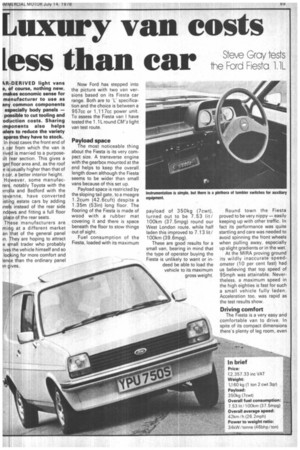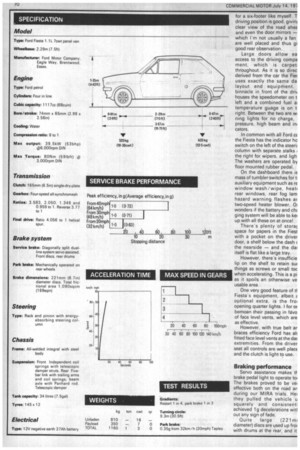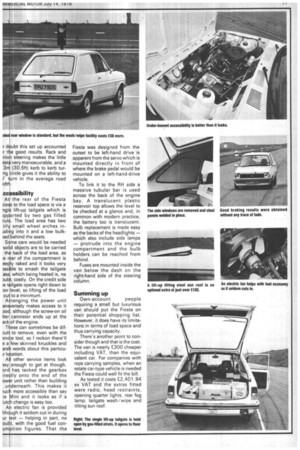uxury van costs ss than ear
Page 71

Page 72

Page 73

If you've noticed an error in this article please click here to report it so we can fix it.
Steve Gray tests
-ne Forc Fiesta 1.1L klITDERIVED light vans e, Of course, nothing new. makes economic sense for m nufacturer to use as an common components esecially body panels — possible to cut tooling and oduction costs. Sharing
■ mponents also helps alers to reduce the variety spares they have to stock. In most cases the front end of a car from which the van is riv d is married to a purposelilt tear section. This gives a • ge floor area and, as the roof e i usually higher than that of c r, a better interior height. However, some manufacrers, notably Toyota with the irrolla and Bedford with the ievanne, have converted isting estate cars by adding inel instead of the rear side nd ws and fitting a full floor pla e of the rear seats.
T ese manufacturers are rni g at a different market an hat of the general panel in. They are hoping to attract e shiall trader who probably ives the vehicle himself and so lociking for more comfort and len e than the ordinary panel in dives.
Now Ford has stepped into the picture with two van versions based on its Fiesta car range. Both are to "L' specification and the choice is between a 957cc or 1.117cc power unit. To assess the Fiesta van I have tested the 1.1L round CM's light van test route.
Payload space
The most noticeable thing about the Fiesta is its very compact size. A transverse engine with the gearbox mounted at the end helps to keep the overall length down although the Fiesta seems to be wider than small vans because of this set up.
Payload space is restricted by the sloping tail gate, to a meagre 1.2cum (42.6cuft) despite a 1.35m (53in) long floor. The flooring of the Fiesta is made of wood with a rubber mat covering it and there is space beneath the floor to stow things out of sight.
Fuel consumption of the Fiesta, loaded with its maximum payload of 350kg (7cwt), turned out to be 7.53 lit/ 100km (37.5mpg) round our West London route, while half laden this improved to 7.13 lit/ 100km (39.6mpg).
These are good results for a small van, bearing in mind that the type of operator buying the Fiesta is unlikely to want or indeed be able to load the vehicle to its maximum gross weight. Round town the Fiesta proved to be very nippy — easily keeping up with other traffic. In fact its performance was quite startling and care was needed to avoid spinning the front wheels when pulling away, especially up slight gradients or in the wet.
At the MIRA proving ground its wildly inaccurate speedometer (10 per cent fast) had us believing that top speed of 95mph was attainable. Nevertheless, a maximum speed in the high eighties is fast for such a small vehicle fully laden. Acceleration too, was rapid as the test results show.
Driving comfort
The Fiesta is a very easy and comfortable van to drive. In spite of its compact dimensions there's plenty of leg room, even for a six-footer like myself. T driving position is good, givini clear view of the road aheE and even the door mirrors — which I'm not usually a fan are well placed and thus gi good rear observation.
Large doors allow ea access to the driving compa ment, which is carpet, throughout. As it is so direc derived from the car the Fie. uses exactly the same da layout and equipment. binnacle in front of the driN, houses the speedometer on t left and a combined fuel al temperature guage is on t right. Between the two are wi ning lights for no charge, pressure, high beam and ini cators.
In common with all Ford cz the Fiesta has the indicator ho switch on the left of the steerii column with separate stalks the right for wipers, and ligh. The washers are operated by floor mounted rubber pedal.
On the dashboard there is mass of tumblerswitches for tl auxiliary equipment such as re window wash/wipe, heat( rear windows, rear fog lam hazard warning flashes ar two-speed heater blower. 01 wonders if the battery and cI-1 ging system will be able to kei up with all these on at once!
There's plenty of storac space for papers in the Fiest with a pocket on the driver door, a shelf below the dash ( the nearside — and the de: itself is flat like a large tray.
However, there's insufficie lip on the shelf to retain sur things as screws or small toc when accelerating. This is a pi as it spoils an otherwise ve usable area.
One very good feature of tt Fiesta's equipment, albeit C optional extra, is the froi opening quarter lights. I for or bemoan their passing in favo of face level vents, which are as effective.
However, with true belt ar braces efficiency Ford has alE fitted face level vents at the da: extremities. From the driver seat all controls are well placE and the clutch is light to use.
Braking performance Servo assistance makes tlbrake pedal light to operate tog The brakes proved to be vei effective both on the road an during our MIRA trials. Hei they pulled the vehicle u squarely and consistentl achieved 1 g decelerations witl out any sign of fade.
Quite large (2 2 1 mt diameter) discs are used up trot with drums at the rear, and it ) doubt this set up accounted the good results. Rack and niop steering makes the little esta very manoeuvrable, and a 3rn(30.5ft) kerb to kerb turng bircie gives it the ability to urn in the average road
ecessibility At the rear of the Fiesta :cess to the load space is via a ngle lift-up tailgate which is ippprted by two gas filled rut 4. The load area has two irl small wheel arches inudiifig into it and a low bulk?ad behind the seats.
ScIme care would be needed sold objects are to be carried the back of the load area, as le rear of the compartment is eeply raked and it looks very )ssible to smash the tailgate ass which being heated is, no pubk, costly. On the credit side le tailgate opens right down to or level, so lifting of the load cut to a minimum.
Arranging the power unit ansversely makes access to it pod, although the screw-on oil lter cannister ends up at the ack of the engine.
T ese can sometimes be difcul to remove, even with the 3rvi e tool, so I reckon there'll e a few skinned knuckles and ars words about this particu ir I ation.
Al other service items look 3sy enough to get at though. ordl has -tacked the gearbox ire4tly onto the end of the owlr unit rather than building urlderneath. This makes it iuclh more accessible than say le Mini and it looks as if a lutch change is easy too.
A electric fan is provided Ithqugh it seldom cut in during ur lest — helping in part, no mitt, with the good fuel conumption figures. That the Fiesta was designed from the outset to be left-hand drive is apparent from the servo which is mounted directly in front of where the brake pedal would be mounted on a left-hand-drive vehicle.
To link it to the RH side a massive tubular bar is used across the back of the engine bay. A translucent plastic reservoir top allows the level to be checked at a glance and, in common with modern practice, the battery too is translucent. Bulb replacement is made easy as the backs of the headlights — which also include side lamps — protrude into the engine compartment and the bulb holders can be reached from behind, Fuses are mounted inside the van below the dash on the right-hand side of the steering column.
Summing up
Own-account people requiring a small but luxurious van should put the Fiesta on their potential shopping list. However, it does have its limitations in terms of load space and thus carrying capacity.
There's another point to consider though and that is the cost. The van is nearly £300 cheaper including VAT, than the equivalent car. For companies with reps carrying samples, when an estate car-type vehicle is needed the Fiesta could well fit the bill.
As tested it costs £2,401.94 ex VAT and the extras fitted were radio, head restraints, opening quarter lights, rear fog lamp, tailgate wash /wipe and tilting sun roof,








































































































































